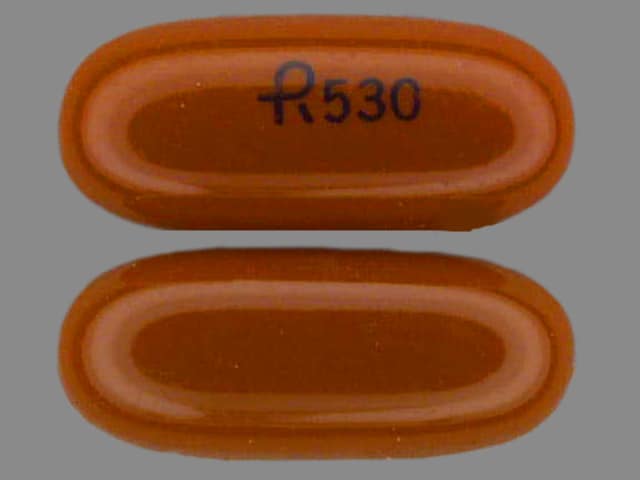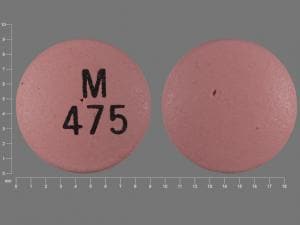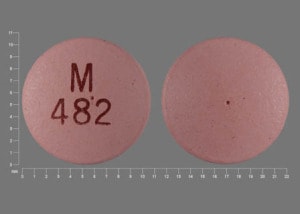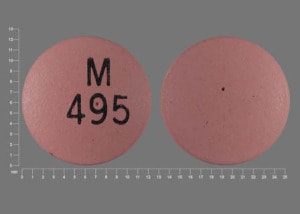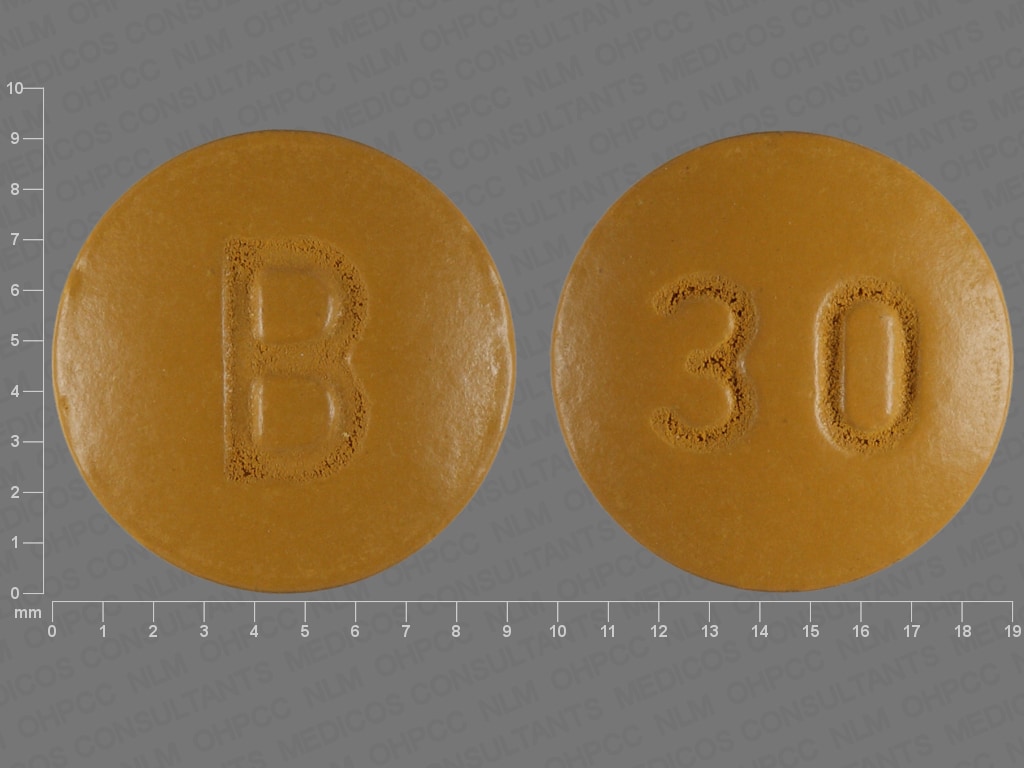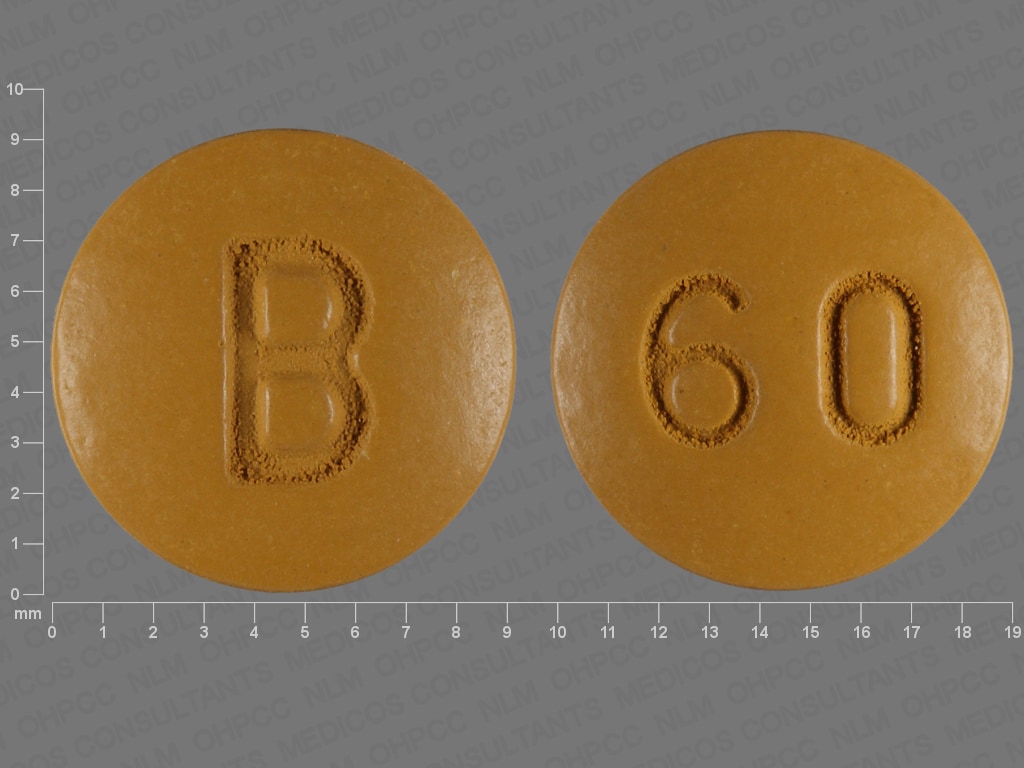Dosage Forms
Excipient information presented when available (limited, particularly for generics); consult specific product labeling. [DSC] = Discontinued product
Capsule, Oral:
Procardia: 10 mg
Generic: 10 mg, 20 mg
Tablet Extended Release 24 Hour, Oral:
Adalat CC: 30 mg, 60 mg, 90 mg [contains corn starch]
Afeditab CR: 30 mg [DSC], 60 mg [DSC]
Nifedical XL: 30 mg [DSC], 60 mg [DSC]
Procardia XL: 30 mg, 60 mg, 90 mg
Generic: 30 mg, 60 mg, 90 mg
Pharmacology
Mechanism of Action
Inhibits calcium ion from entering the “slow channels” or select voltage-sensitive areas of vascular smooth muscle and myocardium during depolarization, producing a relaxation of coronary vascular smooth muscle and coronary vasodilation; increases myocardial oxygen delivery in patients with vasospastic angina; also reduces peripheral vascular resistance, producing a reduction in arterial blood pressure.
Pharmacokinetics/Pharmacodynamics
Metabolism
Hepatic via CYP3A4 to inactive metabolites
Excretion
Urine (60% to 80% as inactive metabolites); feces
Onset of Action
Immediate release: ~20 minutes
Half-Life Elimination
Adults: Healthy: 2 to 5 hours; Cirrhosis: 7 hours; Elderly: 7 hours (extended release tablet)
Protein Binding
Concentration dependent: 92% to 98%; Note: Protein-binding may be significantly decreased in patients with renal or hepatic impairment
Use in Specific Populations
Special Populations: Elderly
Mean Cmax is 36% higher and plasma concentration is 70% greater in elderly patients.
Use: Labeled Indications
Angina: Management of chronic stable or vasospastic angina.
Hypertension: Management of hypertension (ER products only).
Use: Off Label
Anal fissureb
Data from randomized, controlled trials support the use of topical nifedipine in the treatment of anal fissures Agrawal 2013, Ezri 2003.
High-altitude pulmonary edemacyes
Data from a limited number of patients studied suggest that nifedipine may be beneficial for the prevention and treatment of high-altitude pulmonary edema Bärtsch 1991, Oelz 1992. A more recent prospective cross-sectional study demonstrated that nifedipine treatment did not have a beneficial effect when used as an adjunct to descent and oxygen therapy in patients with high-altitude pulmonary edema Deshwal 2012.
Based on the Wilderness Medical Society consensus guidelines for the prevention and treatment of acute altitude illness, the use of ER nifedipine is an effective and recommended option for the prevention and treatment (as an adjunct to descent, oxygen, or portable hyperbaric therapy) of this condition. Overall, supplemental oxygen and descent are the mainstays of therapy for individuals with high-altitude pulmonary edema. For prevention, nifedipine should only be considered for those with a history of high-altitude pulmonary edema (especially multiple episodes).
Hypertensive emergency in pregnancy or postpartum (including acute-onset hypertension in preeclampsia/eclampsia)yes
Based on the American College of Obstetricians and Gynecologists (ACOG) guideline on emergent therapy for acute-onset, severe hypertension during pregnancy and the postpartum period, the use of immediate-release oral nifedipine is effective and recommended as a treatment option in pregnant and postpartum patients who are experiencing acute-onset, severe hypertension ACOG 767 2019.
Pulmonary arterial hypertension (group 1)byes
Data from an open-label observational study evaluating patients with pulmonary hypertension who responded initially to calcium channel blocker therapy and were treated with either nifedipine or diltiazem for up to 5 years support the use of nifedipine in the treatment of this condition Rich 1992.
Based on the 2019 American College of Chest Physicians guideline on pharmacologic therapy for pulmonary arterial hypertension, the 2009 American College of Cardiology/American Heart Association consensus document on pulmonary hypertension, and the 2015 European Society of Cardiology/European Respiratory Society guidelines for the diagnosis and treatment of pulmonary hypertension, the use of nifedipine is an effective and recommended treatment option for patients with group 1 pulmonary hypertension who have a positive vasoreactivity test.
Raynaud phenomenona
Data from a randomized, double-blind, controlled clinical trial in patients with primary Raynaud phenomenon support the use of nifedipine for the treatment of this condition Raynaud's Treatment Study Investigators 2000. Clinical experience also suggests the utility of nifedipine for the treatment of this condition Goundry 2012, Wigley 2002.
For women who are breastfeeding and experiencing Raynaud phenomenon of the nipple, data from a limited number of patients studied (case report and case series) suggest that nifedipine may also be used to treat Raynaud phenomenon of the nipple Barrett 2013, Wu 2012.
Tocolysisyes
Based on the American College of Obstetricians and Gynecologists (ACOG) guidelines for the management of preterm labor, calcium channel blockers, such as nifedipine, are an effective and recommended treatment option for the management of preterm labor to prolong pregnancy and allow for the administration of antenatal steroids ACOG 171 2016.
Contraindications
Hypersensitivity to nifedipine or any component of the formulation
Note: Considered contraindicated in patients with ST-elevation myocardial infarction (STEMI) (ACCF/AHA [O'Gara 2013]); avoid use (Elkayam 1990; Yancy 2013).
Canadian labeling: Additional contraindications (not in US labeling): Severe hypotension; cardiovascular shock; breast-feeding; pregnancy or women of childbearing potential. Note: SOGC and ACOG guidelines recommend nifedipine as a preferred agent for maternal hypertension (ACOG 2013; SOGC [Magee 2014]). Extended release only: Hypersensitivity to other dihydropyridine calcium antagonists; Kock pouch (ileostomy after proctocolectomy); moderate or severe hepatic impairment; severe gastrointestinal obstructive disorders, concomitant use with rifampicin
Dosage and Administration
Dosing: Adult
Note: The use of immediate-release sublingual nifedipine is not recommended for any indication due to safety concerns. Dosage forms: Available preparations include immediate-release capsules (typically given 3 times per day) and extended-release (ER) tablets (typically given once daily). When switching from immediate-release to ER formulations, use same total daily dose.
Anal fissure (off-label use): Note: Administered topically as a local vasodilator in conjunction with supportive measures. Ointment and gel are not commercially available and must be prepared by a licensed compounding facility (Bleday 2019).
Intra-anal: 0.2% to 0.3% ointment or gel: Apply on or around fissure(s) 2 to 4 times daily for 4 weeks (Agrawal 2013; Bleday 2019; Ezri 2003).
Angina pectoris:
Chronic stable angina (alternative agent): Note: A beta-blocker is the preferred initial therapy; if there are ongoing symptoms on beta-blocker therapy, a long-acting dihydropyridine calcium channel blocker (eg, ER nifedipine) may be added; ER nifedipine may also be used as an alternative therapy if there are contraindications or unacceptable adverse effects with beta-blockade (ACCF/AHA [Fihn 2012]). Use of immediate-release nifedipine (oral or sublingual) is not recommended due to increased adverse effects (hypotension and reflex tachycardia), particularly in absence of a beta-blocker.
Oral: Extended release: Initial: 30 or 60 mg once daily; increase as needed to effective antianginal dose over 1 to 2 weeks. Doses >90 mg/day are rarely needed; maximum: 120 mg/day.
Vasospastic angina: Note: May be used alone or in combination with nitrates (ACC/AHA [Fihn 2012]). Use of immediate-release nifedipine (oral or sublingual) is not recommended due to increased adverse effects (hypotension and reflex tachycardia).
Oral: Extended release: Initial: 30 or 60 mg once daily; increase as needed to effective antianginal dose over 1 to 2 weeks. Doses >90 mg/day are rarely needed; maximum: 120 mg/day.
High-altitude pulmonary edema (adjunctive therapy) (off-label use):
Prevention: Note: Adjunct to gradual ascent in higher-risk individuals (eg, history of high-altitude pulmonary edema or other predisposing factors) (WMS [Luks 2014]).
Oral: Extended release: 30 mg every 12 hours starting 24 hours prior to ascent; continue for 5 days after reaching maximal altitude; can extend beyond 5 days in high-risk circumstances (eg, descent impossible) (WMS [Luks 2014]).
Treatment: Note: Adjunctive therapy to nonpharmacologic measures (eg, oxygen supplementation, portable hyperbaric chamber, gradual descent to lower altitude) or as monotherapy if nonpharmacologic measures are not possible (WMS [Luks 2014]).
Oral: Extended release: 30 mg every 12 hours (WMS [Luks 2014]).
Hypertension: Note: For initial treatment in patients with blood pressure ≥20/10 mm Hg above goal, may be used in combination with another appropriate agent (eg, ACE inhibitor, ARB, thiazide diuretic). For patients <20/10 mm Hg above goal, some experts recommend an initial trial of monotherapy (Mann 2019); however, over time, many patients will require combination therapy (ACC/AHA [Whelton 2018]; Mann 2019). Immediate-release nifedipine (oral or sublingual) should not be used for acute blood-pressure lowering due to risk of severe hypotension, which can cause cerebral and/or myocardial ischemia.
Oral: Extended release: Initial: 30 or 60 mg once daily; increase dose as needed based on response and tolerability every 1 to 2 weeks; usual dosage range: 30 to 90 mg once daily (ACC/AHA [Whelton 2018]).
Hypertensive emergency in pregnancy or postpartum (including acute-onset hypertension in preeclampsia/eclampsia) (off-label use): Oral:
Extended release: Initial: 30 mg; repeat 30 mg after 1 to 2 hours if target blood pressure is not achieved; if systolic or diastolic blood pressure remains above threshold after the second dose, another class of agents should be considered (August 2019).
Immediate release (alternative agent): Note: Generally reserved for use when IV access is not available. Some experts avoid use of immediate-release formulations as it may be associated with precipitous drops in blood pressure in some women (August 2019). Do not puncture capsule or administer sublingually (ACOG 767 2019).
Initial: 10 mg once with fetal heart rate monitoring. If systolic or diastolic blood pressure remains above target at 20 minutes, give 10 or 20 mg orally depending on initial response. If blood pressure remains above target after 40 minutes, give another dose of 10 or 20 mg depending on previous response. If target blood pressure is not achieved after third dose, another class of agents should be considered (ACOG 202 2019; ACOG 767 2019; August 2019).
Pulmonary arterial hypertension (group 1) (off-label use): Note: Only used for rigorously selected group 1 pulmonary arterial hypertension patients with a positive vasoreactivity test and under the care of a pulmonary hypertension specialist (ACCP [Klinger 2019]; ESC/ERS [Galiè 2016]; Taichman 2014]). European guidelines recommend a 12-hour, sustained-release formulation that is not available in the United States; dosing is provided empirically for the ER formulation.
Oral: Extended release: 60 mg once daily; titrate gradually and with close hemodynamic monitoring; reported dose range: 120 to 240 mg/day (ACCP [Klinger 2019]; ESC/ERS [Galiè 2016]; Taichman 2014). Some experts initiate therapy at 30 mg once daily (Hopkins 2019).
Raynaud phenomenon (off-label use): Oral:
Extended release: Initial: 30 mg once daily; if needed, may increase dose gradually, usually once every 4 weeks, but not more frequently than once every 7 to 10 days; monitor blood pressure closely with each dose increase; usual effective dose: 30 to 120 mg/day (Thompson 2005; Wigley 2019).
Immediate release: Note: Only for short-term use in closely monitored hospitalized patients with severe digital ischemia who are not yet receiving first-line therapy. Initial: 10 mg 3 times daily; titrate by 10 mg increments every 4 to 6 hours if needed, up to 30 mg 3 times daily; transition to an ER formulation for maintenance therapy (Thompson 2005; Wigley 2002; Wigley 2019).
Tocolysis (off-label use): Oral: Immediate release: Initial: 20 to 30 mg as a loading dose, followed by 10 to 20 mg every 3 to 8 hours for up to 48 hours; maximum dose: 180 mg/day (ACOG 171 2016; Simhan 2019).
Dosing: Geriatric
Note: Avoid immediate-release formulation (Beers Criteria [AGS 2019]).
Refer to adult dosing. In the management of hypertension, consider lower initial doses and titrate to response (Aronow 2011).
Dosing: Pediatric
Hypertension, severe: Limited data available: Note: Use should be under the supervision of a specialist experienced in the management of pediatric hypertension in the inpatient tertiary setting and used only after other alternatives have been shown to be ineffective. Current pediatric blood pressure guidelines do not recommend nifedipine for the management of acute severe hypertension, as other safe and effective alternatives are available for use in the pediatric population (eg, hydralazine, isradipine) (AAP [Flynn 2017]; Flynn 2003). If treatment with nifedipine is deemed appropriate and necessary, then administration should occur in the inpatient setting where blood pressure and other hemodynamic parameters can be closely monitored.
Children and Adolescents: Immediate release: Oral: 0.04 to 0.25 mg/kg/dose; maximum single dose: 10 mg/dose; may repeat if needed every 4 to 6 hours; monitor carefully; maximum daily dose: 1 to 2 mg/kg/day (Blaszak 2001; Egger 2002; Singh 2012; Yiu 2004).
Hypertension; chronic therapy: Limited data available: Children and Adolescents (able to swallow whole tablet): Extended release: Oral: Initial: 0.25 to 0.5 mg/kg/day once daily or divided in 2 doses every 12 hours; do not exceed initial adult daily dose of 30 to 60 mg/day; titrate dose to effect; maximum daily dose: 3 mg/kg/day up to 120 mg/day (AAP [Flynn 2017]; NHLBI 2011); some centers use a higher maximum dose: 3 mg/kg/day up to 180 mg/day (Flynn 2000). Note: Doses are usually titrated upward over 7 to 14 days; may increase over 3 days if clinically necessary.
High altitude pulmonary edema (Pollard 2001): Limited data available: Children and Adolescents: Note: Reserve treatment with NIFEdipine for unsatisfactory response to oxygen and/or altitude descent: Oral:
Immediate release: 0.5 mg/kg/dose every 8 hours; maximum dose: 20 mg/dose
Extended release (preferred): 1.5 mg/kg/day given once daily or divided in 2 doses per day; maximum dose: 40 mg/dose; usual adult dose is 30 mg every 12 hours (Luks 2014)
Extemporaneously Prepared
4 mg/mL Oral Suspension (ASHP Standard Concentration) (ASHP 2017)
A 4 mg/mL oral suspension may be made with liquid capsules (Note: Concentration inside capsule may vary depending on manufacturer. Procardia: 10 mg capsule contains a concentration of 10 mg/0.34 mL [29.4 mg/mL]). Puncture the top of twelve 10 mg liquid capsules with one needle to create a vent. Insert a second needle attached to a syringe and extract the liquid; transfer to a calibrated bottle and add sufficient quantity of a 1:1 mixture of Ora-Sweet and Ora-Plus to make 30 mL. Label "shake well". Stable 90 days under refrigeration or at room temperature.
Nahata MC, Morosco RS, and Willhite EA, "Stability of Nifedipine in Two Oral Suspensions Stored at Two Temperatures," J Am Pharm Assoc, 2002, 42(6):865-7.
Administration
Oral:
Immediate release: In general, may be administered with or without food.
Extended release: Tablets should be swallowed whole; do not crush, split, or chew.
Adalat CC, Afeditab CR: Administer on an empty stomach (per manufacturer). Other extended release products may not have this recommendation; consult product labeling.
Dietary Considerations
Avoid grapefruit juice with all products.
Immediate release: Capsule is rapidly absorbed orally if it is administered without food, but may result in vasodilator side effects; if flushing is problematic, administration with low-fat meals may decrease. In general, can take with or without food.
Extended release: Adalat CC, Afeditab CR: Take on an empty stomach (manufacturer's labeling). Other extended release products may not have this recommendation; consult product labeling.
Storage
Adalat CC, Afeditab CR, Procardia XL: Store below 30°C (86°F); protect from light and moisture.
Nifedical XL: Store at 25°C (77°F); excursions permitted to 15°C to 30°C (59°F to 86°F); protect from light and moisture.
Immediate release capsules (Procardia): Store at 15°C to 25°C (59°F to 77°F); prevent capsules from freezing; protect from light and moisture.
NIFEdipine Images
Drug Interactions
Alcohol (Ethyl): May increase the serum concentration of NIFEdipine. Monitor therapy
Alfuzosin: May enhance the hypotensive effect of Blood Pressure Lowering Agents. Monitor therapy
Alpha1-Blockers: May enhance the hypotensive effect of Calcium Channel Blockers. Monitor therapy
Amifostine: Blood Pressure Lowering Agents may enhance the hypotensive effect of Amifostine. Management: When amifostine is used at chemotherapy doses, blood pressure lowering medications should be withheld for 24 hours prior to amifostine administration. If blood pressure lowering therapy cannot be withheld, amifostine should not be administered. Consider therapy modification
Amphetamines: May diminish the antihypertensive effect of Antihypertensive Agents. Monitor therapy
Antifungal Agents (Azole Derivatives, Systemic): May enhance the adverse/toxic effect of Calcium Channel Blockers. Specifically, itraconazole may enhance the negative inotropic effects of verapamil or diltiazem. Antifungal Agents (Azole Derivatives, Systemic) may decrease the metabolism of Calcium Channel Blockers. Fluconazole and isavuconazonium likely exert weaker effects than other azoles and are addressed in separate monographs. Management: Concurrent use of felodipine or nisoldipine with itraconazole is specifically contraindicated. Frequent monitoring is warranted with any such combination; calcium channel blocker dose reductions may be required. Exceptions: Fluconazole; Isavuconazonium Sulfate. Consider therapy modification
Antipsychotic Agents (Second Generation [Atypical]): Blood Pressure Lowering Agents may enhance the hypotensive effect of Antipsychotic Agents (Second Generation [Atypical]). Monitor therapy
Aprepitant: May increase the serum concentration of CYP3A4 Substrates (High risk with Inhibitors). Monitor therapy
Atosiban: Calcium Channel Blockers may enhance the adverse/toxic effect of Atosiban. Specifically, there may be an increased risk for pulmonary edema and/or dyspnea. Monitor therapy
Barbiturates: May increase the metabolism of Calcium Channel Blockers. Management: Monitor for decreased therapeutic effects of calcium channel blockers with concomitant barbiturate therapy. Calcium channel blocker dose adjustments may be necessary. Nimodipine Canadian labeling contraindicates concomitant use with phenobarbital. Monitor therapy
Barbiturates: May enhance the hypotensive effect of Blood Pressure Lowering Agents. Monitor therapy
Benperidol: May enhance the hypotensive effect of Blood Pressure Lowering Agents. Monitor therapy
Beta-Blockers: NIFEdipine may enhance the hypotensive effect of Beta-Blockers. NIFEdipine may enhance the negative inotropic effect of Beta-Blockers. Monitor therapy
Bosentan: May decrease the serum concentration of CYP3A4 Substrates (High risk with Inducers). Monitor therapy
Brigatinib: May diminish the antihypertensive effect of Antihypertensive Agents. Brigatinib may enhance the bradycardic effect of Antihypertensive Agents. Monitor therapy
Brimonidine (Topical): May enhance the hypotensive effect of Blood Pressure Lowering Agents. Monitor therapy
Bromperidol: Blood Pressure Lowering Agents may enhance the hypotensive effect of Bromperidol. Bromperidol may diminish the hypotensive effect of Blood Pressure Lowering Agents. Avoid combination
Calcium Channel Blockers (Nondihydropyridine): Calcium Channel Blockers (Dihydropyridine) may enhance the hypotensive effect of Calcium Channel Blockers (Nondihydropyridine). Calcium Channel Blockers (Nondihydropyridine) may increase the serum concentration of Calcium Channel Blockers (Dihydropyridine). Monitor therapy
Calcium Salts: May diminish the therapeutic effect of Calcium Channel Blockers. Monitor therapy
Cimetidine: May increase the serum concentration of Calcium Channel Blockers. Management: Consider alternatives to cimetidine. If no suitable alternative exists, monitor for increased effects of calcium channel blockers following cimetidine initiation/dose increase, and decreased effects following cimetidine discontinuation/dose decrease. Consider therapy modification
Cisapride: May increase the serum concentration of NIFEdipine. Reported with sustained release nifedipine product. Monitor therapy
Cladribine: Inhibitors of Equilibrative Nucleoside (ENT1) and Concentrative Nucleoside (CNT3) Transport Proteins may increase the serum concentration of Cladribine. Management: Avoid concomitant use of ENT1 or CNT3 inhibitors during the 4 to 5 day oral cladribine treatment cycles whenever possible. If combined, consider an ENT1 or CNT3 inhibitor dose reduction and separation in the timing of administration. Consider therapy modification
Clofazimine: May increase the serum concentration of CYP3A4 Substrates (High risk with Inhibitors). Monitor therapy
Clopidogrel: Calcium Channel Blockers may diminish the therapeutic effect of Clopidogrel. Monitor therapy
Conivaptan: May increase the serum concentration of CYP3A4 Substrates (High risk with Inhibitors). Avoid combination
CycloSPORINE (Systemic): Calcium Channel Blockers (Dihydropyridine) may increase the serum concentration of CycloSPORINE (Systemic). CycloSPORINE (Systemic) may increase the serum concentration of Calcium Channel Blockers (Dihydropyridine). Monitor therapy
CYP3A4 Inducers (Moderate): May decrease the serum concentration of CYP3A4 Substrates (High risk with Inducers). Monitor therapy
CYP3A4 Inducers (Strong): May decrease the serum concentration of NIFEdipine. Avoid combination
CYP3A4 Inhibitors (Moderate): May decrease the metabolism of CYP3A4 Substrates (High risk with Inhibitors). Monitor therapy
CYP3A4 Inhibitors (Strong): May decrease the metabolism of CYP3A4 Substrates (High risk with Inhibitors). Consider therapy modification
Dabrafenib: May decrease the serum concentration of CYP3A4 Substrates (High risk with Inducers). Management: Seek alternatives to the CYP3A4 substrate when possible. If concomitant therapy cannot be avoided, monitor clinical effects of the substrate closely (particularly therapeutic effects). Consider therapy modification
Dapoxetine: May enhance the orthostatic hypotensive effect of Calcium Channel Blockers. Monitor therapy
Deferasirox: May decrease the serum concentration of CYP3A4 Substrates (High risk with Inducers). Monitor therapy
Dexmethylphenidate: May diminish the therapeutic effect of Antihypertensive Agents. Monitor therapy
Diazoxide: May enhance the hypotensive effect of Blood Pressure Lowering Agents. Monitor therapy
Digoxin: NIFEdipine may increase the serum concentration of Digoxin. Monitor therapy
DULoxetine: Blood Pressure Lowering Agents may enhance the hypotensive effect of DULoxetine. Monitor therapy
Duvelisib: May increase the serum concentration of CYP3A4 Substrates (High risk with Inhibitors). Monitor therapy
Efavirenz: May decrease the serum concentration of Calcium Channel Blockers. Monitor therapy
Erdafitinib: May decrease the serum concentration of CYP3A4 Substrates (High risk with Inducers). Monitor therapy
Erdafitinib: May increase the serum concentration of CYP3A4 Substrates (High risk with Inhibitors). Monitor therapy
Fluconazole: May increase the serum concentration of Calcium Channel Blockers. Monitor therapy
FLUoxetine: May enhance the adverse/toxic effect of NIFEdipine. Monitor therapy
Fosaprepitant: May increase the serum concentration of CYP3A4 Substrates (High risk with Inhibitors). Monitor therapy
Fosnetupitant: May increase the serum concentration of CYP3A4 Substrates (High risk with Inhibitors). Monitor therapy
Fusidic Acid (Systemic): May increase the serum concentration of CYP3A4 Substrates (High risk with Inhibitors). Avoid combination
Grapefruit Juice: May increase the serum concentration of NIFEdipine. Avoid combination
Herbs (Hypertensive Properties): May diminish the antihypertensive effect of Antihypertensive Agents. Monitor therapy
Herbs (Hypotensive Properties): May enhance the hypotensive effect of Blood Pressure Lowering Agents. Monitor therapy
Hypotension-Associated Agents: Blood Pressure Lowering Agents may enhance the hypotensive effect of Hypotension-Associated Agents. Monitor therapy
Idelalisib: May increase the serum concentration of CYP3A4 Substrates (High risk with Inhibitors). Avoid combination
Ivosidenib: May decrease the serum concentration of CYP3A4 Substrates (High risk with Inducers). Monitor therapy
Larotrectinib: May increase the serum concentration of CYP3A4 Substrates (High risk with Inhibitors). Monitor therapy
Levodopa-Containing Products: Blood Pressure Lowering Agents may enhance the hypotensive effect of Levodopa-Containing Products. Monitor therapy
Lorlatinib: May decrease the serum concentration of CYP3A4 Substrates (High risk with Inducers). Management: Avoid concurrent use of lorlatinib with any CYP3A4 substrates for which a minimal decrease in serum concentrations of the CYP3A4 substrate could lead to therapeutic failure and serious clinical consequences. Consider therapy modification
Lormetazepam: May enhance the hypotensive effect of Blood Pressure Lowering Agents. Monitor therapy
Macrolide Antibiotics: May decrease the metabolism of Calcium Channel Blockers. Management: Consider using a noninteracting macrolide. Felodipine Canadian labeling specifically recommends avoiding its use in combination with clarithromycin. Exceptions: Azithromycin (Systemic); Fidaxomicin; Roxithromycin; Spiramycin. Consider therapy modification
Magnesium Salts: Calcium Channel Blockers may enhance the adverse/toxic effect of Magnesium Salts. Magnesium Salts may enhance the hypotensive effect of Calcium Channel Blockers. Monitor therapy
Melatonin: May diminish the antihypertensive effect of Calcium Channel Blockers (Dihydropyridine). Monitor therapy
Methylphenidate: May diminish the antihypertensive effect of Antihypertensive Agents. Monitor therapy
MiFEPRIStone: May increase the serum concentration of CYP3A4 Substrates (High risk with Inhibitors). Management: Minimize doses of CYP3A4 substrates, and monitor for increased concentrations/toxicity, during and 2 weeks following treatment with mifepristone. Avoid cyclosporine, dihydroergotamine, ergotamine, fentanyl, pimozide, quinidine, sirolimus, and tacrolimus. Consider therapy modification
Molsidomine: May enhance the hypotensive effect of Blood Pressure Lowering Agents. Monitor therapy
Nafcillin: May decrease the serum concentration of NIFEdipine. Consider therapy modification
Naftopidil: May enhance the hypotensive effect of Blood Pressure Lowering Agents. Monitor therapy
Netupitant: May increase the serum concentration of CYP3A4 Substrates (High risk with Inhibitors). Monitor therapy
Neuromuscular-Blocking Agents (Nondepolarizing): Calcium Channel Blockers may enhance the neuromuscular-blocking effect of Neuromuscular-Blocking Agents (Nondepolarizing). Monitor therapy
Nicergoline: May enhance the hypotensive effect of Blood Pressure Lowering Agents. Monitor therapy
Nicorandil: May enhance the hypotensive effect of Blood Pressure Lowering Agents. Monitor therapy
Nitroprusside: Blood Pressure Lowering Agents may enhance the hypotensive effect of Nitroprusside. Monitor therapy
Obinutuzumab: May enhance the hypotensive effect of Blood Pressure Lowering Agents. Management: Consider temporarily withholding blood pressure lowering medications beginning 12 hours prior to obinutuzumab infusion and continuing until 1 hour after the end of the infusion. Consider therapy modification
Palbociclib: May increase the serum concentration of CYP3A4 Substrates (High risk with Inhibitors). Monitor therapy
Pentoxifylline: May enhance the hypotensive effect of Blood Pressure Lowering Agents. Monitor therapy
Phenytoin: NIFEdipine may increase the serum concentration of Phenytoin. Phenytoin may decrease the serum concentration of NIFEdipine. Avoid combination
Pholcodine: Blood Pressure Lowering Agents may enhance the hypotensive effect of Pholcodine. Monitor therapy
Phosphodiesterase 5 Inhibitors: May enhance the hypotensive effect of Blood Pressure Lowering Agents. Monitor therapy
Prostacyclin Analogues: May enhance the hypotensive effect of Blood Pressure Lowering Agents. Monitor therapy
Quinagolide: May enhance the hypotensive effect of Blood Pressure Lowering Agents. Monitor therapy
QuiNIDine: Calcium Channel Blockers (Dihydropyridine) may decrease the serum concentration of QuiNIDine. Calcium Channel Blockers (Dihydropyridine) may increase the serum concentration of QuiNIDine. QuiNIDine may increase the serum concentration of Calcium Channel Blockers (Dihydropyridine). Monitor therapy
Rifamycin Derivatives: May decrease the serum concentration of Calcium Channel Blockers. This primarily affects oral forms of calcium channel blockers. Management: The labeling for some US and Canadian calcium channel blockers contraindicate use with rifampin, however recommendations vary. Consult appropriate labeling. Consider therapy modification
Sarilumab: May decrease the serum concentration of CYP3A4 Substrates (High risk with Inducers). Monitor therapy
Siltuximab: May decrease the serum concentration of CYP3A4 Substrates (High risk with Inducers). Monitor therapy
Simeprevir: May increase the serum concentration of CYP3A4 Substrates (High risk with Inhibitors). Monitor therapy
Sincalide: Drugs that Affect Gallbladder Function may diminish the therapeutic effect of Sincalide. Management: Consider discontinuing drugs that may affect gallbladder motility prior to the use of sincalide to stimulate gallbladder contraction. Consider therapy modification
St John's Wort: May decrease the serum concentration of NIFEdipine. Avoid combination
Stiripentol: May increase the serum concentration of CYP3A4 Substrates (High risk with Inhibitors). Management: Use of stiripentol with CYP3A4 substrates that are considered to have a narrow therapeutic index should be avoided due to the increased risk for adverse effects and toxicity. Any CYP3A4 substrate used with stiripentol requires closer monitoring. Consider therapy modification
Tacrolimus (Systemic): Calcium Channel Blockers (Dihydropyridine) may increase the serum concentration of Tacrolimus (Systemic). Monitor therapy
Tocilizumab: May decrease the serum concentration of CYP3A4 Substrates (High risk with Inducers). Monitor therapy
VinCRIStine: NIFEdipine may increase the serum concentration of VinCRIStine. Monitor therapy
VinCRIStine (Liposomal): NIFEdipine may increase the serum concentration of VinCRIStine (Liposomal). Monitor therapy
Yohimbine: May diminish the antihypertensive effect of Antihypertensive Agents. Monitor therapy
Test Interactions
May lead to false-negative aldosterone/renin ratio (ARR) (Funder 2016)
Adverse Reactions
>10%:
Cardiovascular: Flushing (10% to 25%; extended release: 3% to 4%), peripheral edema (7% to 30%)
Central nervous system: Dizziness (10% to 27%), headache (10% to 23%)
Gastrointestinal: Heartburn (≤11%), nausea (≤11%)
1% to 10%:
Cardiovascular: Palpitations (≤7%), transient hypotension (5%), cardiac failure (2%)
Central nervous system: Mood changes (≤7%), nervousness (≤7%), fatigue (6%), chills (≤2%), disturbed sleep (≤2%), equilibrium disturbance (≤2%), jitteriness (≤2%), shakiness (≤2%)
Dermatologic: Dermatitis (≤2%), diaphoresis (≤2%), pruritus (≤2%), urticaria (≤2%)
Gastrointestinal: Gingival hyperplasia (≤10%), sore throat (≤6%), abdominal cramps (≤2%), constipation (≤2%), diarrhea (≤2%), flatulence (≤2%)
Genitourinary: Sexual difficulty (≤2%)
Neuromuscular & skeletal: Muscle cramps (≤8%), tremor (≤8%), weakness (<3%), joint stiffness (≤2%)
Ophthalmic: Blurred vision (≤2%)
Respiratory: Cough (≤6%), nasal congestion (≤6%), wheezing (≤6%), chest congestion (≤2%), dyspnea (≤2%)
Miscellaneous: Fever (≤2%), inflammation (≤2%)
<1%, postmarketing, and/or case reports: Acute generalized exanthematous pustulosis, agranulocytosis, alopecia, altered sense of smell, anemia, aplastic anemia, angina pectoris, angioedema, arthritis (with positive ANA), bezoar formation, cardiac arrhythmia, cerebral ischemia, depression, dysgeusia, epistaxis, extrapyramidal reaction, erectile dysfunction, erythema multiforme, erythromelalgia, exfoliative dermatitis, facial edema, gastroesophageal reflux disease, gastrointestinal obstruction, gastrointestinal ulcer, gynecomastia, hematuria, hepatitis (allergic), ischemia, leukopenia, malignant neoplasm of lip (Friedman 2012), memory impairment, migraine, myalgia, myoclonus, nocturia, paranoia, parotitis, periorbital edema, polyuria, purpura, skin photosensitivity, Stevens-Johnson syndrome, syncope, tachycardia, thrombocytopenia, tinnitus, toxic epidermal necrolysis, transient blindness, ventricular arrhythmia
Warnings/Precautions
Concerns related to adverse effects:
- Angina/MI: Increased angina and/or MI have occurred with initiation or dosage titration of dihydropyridine calcium channel blockers. Reflex tachycardia may occur resulting in angina and/or MI in patients with obstructive coronary disease, especially in the absence of concurrent beta-blockade. In patients with unstable angina/non-STEMI, the use of immediate-release nifedipine is not recommended except with concomitant beta-blockade (ACCF/AHA [Anderson 2013]).
- Hypotension/syncope: Symptomatic hypotension with or without syncope can rarely occur; blood pressure must be lowered at a rate appropriate for the patient's clinical condition. The use of immediate release nifedipine (sublingually or orally) in hypertensive emergencies and urgencies is neither safe nor effective. Serious adverse events (eg, death, cerebrovascular ischemia, syncope, stroke, acute myocardial infarction, and fetal distress) have been reported. Immediate release nifedipine should not be used for acute blood pressure reduction. Guidelines are available when immediate release nifedipine is required for acute treatment in pregnant or postpartum women (ACOG 767 2019; SOGC [Magee 2014]).
- Peripheral edema: The most common side effect is peripheral edema; occurs within 2 to 3 weeks of starting therapy.
Disease-related concerns:
- Aortic stenosis: Use with extreme caution in patients with severe aortic stenosis; may reduce coronary perfusion resulting in myocardial ischemia.
- GI strictures: Alterations in GI anatomy (eg, severe GI narrowing, history of GI cancer, obstruction, bowel resection, gastric bypass, vertical banded gastroplasty) and underlying hypomotility disorders have led to bezoar formation with extended release forms.
- Heart failure: The ACC/AHA heart failure guidelines recommend to avoid use in patients with HF due to lack of benefit and/or worse outcomes with calcium channel blockers in general (ACC/AHA [Yancy 2013]).
- Hepatic impairment: Use with caution in patients with hepatic impairment. Clearance of nifedipine is reduced in cirrhotic patients leading to increased systemic exposure; monitor closely for adverse effects/toxicity and consider dose adjustments.
- Hypertrophic cardiomyopathy (HCM) with outflow tract obstruction: Use with caution in patients with HCM and outflow tract obstruction since reduction in afterload may worsen symptoms associated with this condition.
Concurrent drug therapy issues:
- Drug-drug interactions: Potentially significant interactions may exist, requiring dose or frequency adjustment, additional monitoring, and/or selection of alternative therapy. Consult drug interactions database for more detailed information.
Dosage form specific issues:
- Extended release formulation: Consists of drug within a nondeformable matrix; following drug release/absorption, the matrix/shell is expelled in the stool. The use of nondeformable products in patients with known stricture/narrowing of the GI tract (eg, severe gastrointestinal narrowing, colon cancer, obstruction, bowel resection, gastric bypass, vertical banded gastroplasty) has been associated with symptoms of obstruction (pharmacobezoar).
- Immediate release formulation: Immediate release formulations should not be used to manage primary hypertension, adequate studies to evaluate outcomes have not been conducted.
- Lactose: Adalat CC tablets contain lactose; do not use with galactose intolerance, Lapp lactase deficiency, or glucose-galactose malabsorption syndromes.
Other warnings/precautions:
- Surgery: Use with caution before major surgery. Cardiopulmonary bypass, intraoperative blood loss or vasodilating anesthesia may result in severe hypotension and/or increased fluid requirements. Consider withdrawing nifedipine (>36 hours) before surgery if possible.
- Withdrawal: Abrupt withdrawal may cause rebound angina in patients with CAD.
Monitoring Parameters
Heart rate, blood pressure, signs and symptoms of HF, peripheral edema
Hypertension: The 2017 Guideline for the Prevention, Detection, Evaluation, and Management of High Blood Pressure in Adults (ACC/AHA [Whelton 2018]):
Confirmed hypertension and known CVD (cardiovascular disease) or 10-year atherosclerotic cardiovascular disease (ASCVD) risk ≥10%: Target blood pressure <130/80 mm Hg is recommended
Confirmed hypertension without markers of increased ASCVD risk: Target blood pressure <130/80 mm Hg may be reasonable
Diabetes and hypertension: The American Diabetes Association (ADA) guidelines (ADA 2019):
Patients 18 to 65 years of age, without ASCVD, and 10-year ASCVD risk <15%: Target blood pressure <140/90 mm Hg is recommended
Patients 18 to 65 years of age and known ASCVD or 10-year ASCVD risk >15%: Target blood pressure <130/80 mm Hg may be appropriate if it can be safely attained
Patients >65 years of age (healthy or complex/intermediate health): Target blood pressure <140/90 mm Hg is recommended
Patients >65 years of age (very complex/poor health): Target blood pressure <150/90 mm Hg is recommended
Pregnancy
Pregnancy Considerations
Nifedipine crosses the placenta (Manninen 1991; Silberschmidt 2008).
An increase in perinatal asphyxia, cesarean delivery, prematurity, and intrauterine growth retardation have been reported following maternal use.
Chronic maternal hypertension may increase the risk of birth defects, low birth weight, preterm delivery, stillbirth, and neonatal death. Actual fetal/neonatal risks may be related to duration and severity of maternal hypertension. Untreated hypertension may also increase the risks of adverse maternal outcomes, including gestational diabetes, MI, preeclampsia, stroke, and delivery complications (ACOG 203 2019).
If treatment for chronic hypertension during pregnancy is needed, oral nifedipine is one of the preferred agents (ACOG 203 2019; ESC [Regitz-Zagrosek 2018]). Oral immediate-release nifedipine is also recommended for the management of acute-onset, severe hypertension in pregnant and postpartum women, including those with preeclampsia or eclampsia (ACOG 767 2019; ESC [Regitz-Zagrosek 2018]).
Nifedipine has also been evaluated for the treatment of preterm labor. Tocolytics may be used for the short-term (48-hour) prolongation of pregnancy to allow for the administration of antenatal steroids and should not be used prior to fetal viability or when the risks of use to the fetus or mother are greater than the risk of preterm birth (ACOG 171 2016). Nifedipine is ineffective for maintenance tocolytic therapy (ACOG 171 2016; Aggarwal 2018; Roos 2013; Verspyck 2017).
Patient Education
What is this drug used for?
- It is used to treat chest pain or pressure.
- Some forms of this drug are approved to treat high blood pressure.
- It may be given to you for other reasons. Talk with the doctor.
Frequently reported side effects of this drug
- Headache
- Flushing
- Heartburn
- Nausea
- Loss of strength and energy
- Anxiety
- Tablet shell in stool
Other side effects of this drug: Talk with your doctor right away if you have any of these signs of:
- Severe dizziness
- Passing out
- Angina
- Abnormal heartbeat
- Mood changes
- Shortness of breath
- Excessive weight gain
- Swelling of arms or legs
- Muscle pain
- Muscle cramps
- Tremors
- Severe abdominal pain
- Severe constipation
- Black, tarry, or bloody stools
- Vomiting blood
- Signs of a significant reaction like wheezing; chest tightness; fever; itching; bad cough; blue skin color; seizures; or swelling of face, lips, tongue, or throat.
Note: This is not a comprehensive list of all side effects. Talk to your doctor if you have questions.
Consumer Information Use and Disclaimer: This information should not be used to decide whether or not to take this medicine or any other medicine. Only the healthcare provider has the knowledge and training to decide which medicines are right for a specific patient. This information does not endorse any medicine as safe, effective, or approved for treating any patient or health condition. This is only a brief summary of general information about this medicine. It does NOT include all information about the possible uses, directions, warnings, precautions, interactions, adverse effects, or risks that may apply to this medicine. This information is not specific medical advice and does not replace information you receive from the healthcare provider. You must talk with the healthcare provider for complete information about the risks and benefits of using this medicine.
